 |
Here are some interesting historical programs given to or hosted by SAHC
SAHC unveils some “Treasures at the Depot”
Members of the Stryker Area Heritage Council brought stories behind “treasures” kept in the Stryker Historical Center, the former train depot, during a program held at the Stryker American Legion on March 8, 2014.
Five people spoke about “treasures” from the depot, items that are tied to important people, businesses or events in the Stryker area.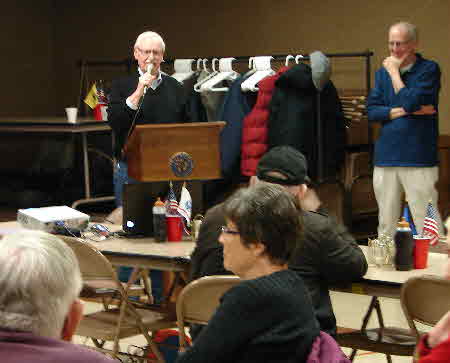
Fred Grisier, shown with microphone in the photo on the right, spoke about Medal of Honor recipient William Knight. Fred detailed William Knight’s early life leading into his part in “The Great Locomotive Chase.” He spoke about the raid behind Confederate lines, the stealing of the train, “The General,” the capture of the soldiers, the escape for some and their return to the Union territory.
After the war, Knight found work as a railroad engineer. When he retired, He returned to Stryker and often spent time on speaking tours across the country to tell of his exploits. When in Stryker, Knight was a tinkerer, and when he died, was buried by Fred’s grandfather in the town cemetery.
Fred showed photos of Mr. Knight’s Medals of Honor, explaining one of the actual medals was on display during a commemoration of Mr. Knight held in Stryker last year. The photos are shown in the depot.
Terry Wieland told the crowd about a baggage cart the council acquired this past summer that had been used at the train depot. He said the cart was purchased at a local auction, and showed several photos of the cart at the depot through the years.
Terry said when the cart was purchased at the sale, it needed some work. Several of the boards needed to be replaced, but the rest of the cart still had its original parts. He said Virgil Frank refurbished the cart, and it is now back at the depot where it used to handle the baggage of travelers who rode the train to and from Stryker.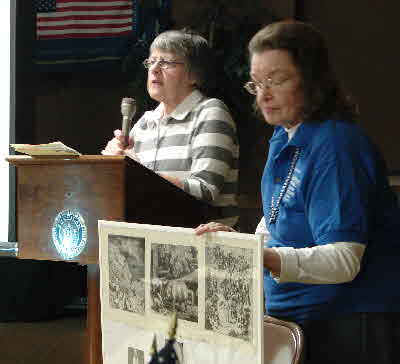
Sue Buehrer, with the microphone at right, told the crowd about Harry Wickey, a famous artist who was a Stryker native. She told about the farm near Stryker where Mr. Wickey grew up and the art schools he attended. She explained how he was known for his etchings, many of which were scenes about farm life. When the chemicals used for the etchings affected his eyesight, he began to work on sculptures.
Helen Bell, shown next to Buehrer in the photo above, showed some copies of prints of his work and a wheel he used at his home. There were also some postcards his wife painted. She was also a well-known artist.
The program concluded with a presentation on the Stryker Boat Oar Company done by Bill Priest. The company was a major employer in the village in the late 1800’s and into the first part of the 1900’s.
John Von Behren and Henry G. Shaffer built a sawmill next to their tannery in the fall of 1866 at the site where the Stryker Village Hall sits today.
By the next year, the sawmill began manufacturing oars, spokes and other wood products. Their business spread, and the company developed a worldwide following for their products.
They survived a fire in 1876 and an explosion in 1884, but another fire in 1926 destroyed the boat oar company. 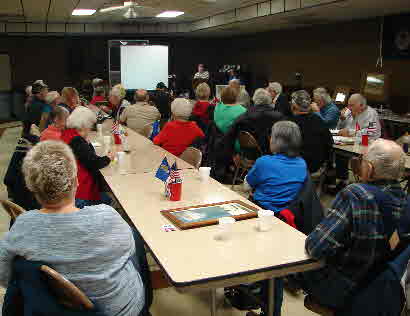
Initially, there were plans to rebuild on the same spot, and the land was cleared for rebuilding. But officials learned of an empty plant in Archbold with a 2-story main building, a kiln, a lumber storage yard, access to the railroad, everything they needed but the equipment. Considering all the orders they had and that the rebuilding process could take a year or so, officials decided to move the plant to Archbold.
Mr. Priest showed some of the oars, paddles, and other products made by the boat oar company as well as a price list from the company.
He also related a story written in the Toledo Blade about the company and shared comments from Howard Brodbeck, one of the former workers at the Archbold plant, about the process they used to produce their special boat oars.
Following the presentations, the crowd was invited to stop by the depot to see some of the treasures there for themselves that capture some of the rich history of the Stryker area.
Crowd fills Legion Hall to hear Toledo & Indiana Electric Railroad program

There were plenty of "passengers" for the trip back in time on the electric interurban railroad during a program hosted by the Stryker Area Heritage Council on Saturday, Feb. 18.
A crowd of about a hundred people turned out at the Stryker American Legion as Dr. Sterling King, noted Toledo and Indiana Railroad author and historian shown on the right in the photo above, served as their conductor on a trip along the line that operated through northwest Ohio.
Dr. King showed rare photos he has collected through the years of the train system that began operation in 1903 running from Toledo eventually expanding to Bryan.
From the first cars that began running down Dorr Street in Toledo, he showed photos of trains going down the main streets of Swanton, Delta, Archbold and Bryan, and some of the stops at Pettisville, Wauseon, Peckham Loop and downtown Toledo. There were also shots of trains going over the bridges at Beaver Creek and the Tiffin River and running through the underpass of the line of the New York Central east of Bryan.
The railroad provided an important route of travel through the area in the early days of the 20th century. There were no paved roads when the train system was formed. The new automobiles could only go about 20 miles per hour and the roads could prove an obstacle when they were muddy or covered with snow. The trains, however, moved much faster, able to clock up to 60 miles per hour out in the country. So they were popular with passengers and with people who wanted to get their products to market and receive supplies from outside the area.
During the program, Dr. King remembered a number of the people who worked on the line and drove the trains along the tracks.
Dr. King also gave interesting sidebars when he talked about the popcorn wagon in Stryker that used steam to pop the corn, the Christmas star built by T & I workers that is still displayed in the south park at Wauseon, and the two specially-made cars with filled wicker chairs and decorative curtains on the windows.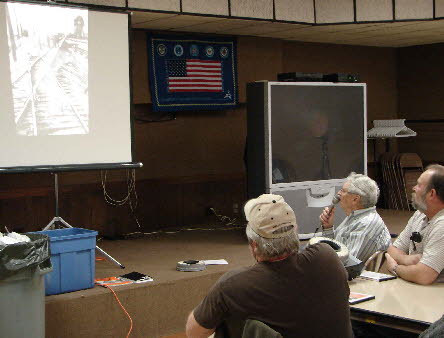
Ridership dropped off as automobiles improved and roads were paved through the area. The train line lived off of its freight business the last years, shuttling fuel cars for Cities Service.
The program drew to a close as Dr. King showed photos of the car that traveled the route on the last day of the line’s operation in 1939.
SAHC offers a 2-hour DVD set about the T & I that is narrated by Dr. King showing many of the photos he included in his presentation.
Buchman Tells Tragic Story of Ohio Indian Removal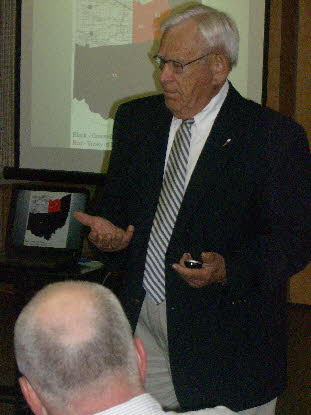
Northwest Ohio was once home to significant numbers of Native Americans including bands of Potawatomi, Wyandotte, Shawnee, Seneca and Ottawa. These tribes peacefully coexisted with the area’s earliest white settlers before they abruptly disappeared.
What happened to them?
The sobering answer is detailed in the recently published book, “A Sorrowful Journey,” by noted area educator and historian Randy Buchman. Buchman shared the painful story of the forced removal of northwest Ohio’s Native Americans during a special October 23, 2008 presentation sponsored by the Stryker Area Heritage Council.
About 70 people listened as Buchman recounted how the Native Americans’ forced relocation as a result of the Indian Removal Act of 1830 is largely an untold and tragic part of our heritage. More than a nearly forgotten page in area history, it is the heartbreaking story of a people and their culture transplanted by government force. Uprooted and fighting for survival, the Native Americans lost many aspects of their culture and identity, a legacy they still struggle with today.
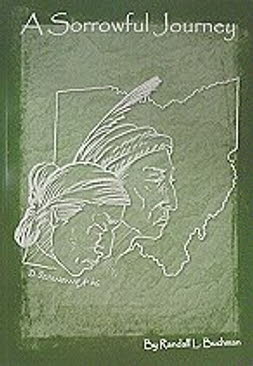 “A Sorrowful Journey” details removal of the Shawnee, Seneca, and Ottawa from Ohio in the 1830s and is based on the recently discovered journal of John Shelby. Shelby was an assistant conductor of these tribes as they made their way on foot along their own “trail of tears” across four states to lands west of the Mississippi River. Shelby accompanied these tribes as they made their way on foot along their "trail of tears" to lands west of the Mississippi River. Suffering from hunger and exposure, nearly one-third died on the three-month journey including many children, who were quickly buried along the route. “A Sorrowful Journey” details removal of the Shawnee, Seneca, and Ottawa from Ohio in the 1830s and is based on the recently discovered journal of John Shelby. Shelby was an assistant conductor of these tribes as they made their way on foot along their own “trail of tears” across four states to lands west of the Mississippi River. Shelby accompanied these tribes as they made their way on foot along their "trail of tears" to lands west of the Mississippi River. Suffering from hunger and exposure, nearly one-third died on the three-month journey including many children, who were quickly buried along the route.
Buchman’s presentation was expanded by PowerPoint reproductions of Shelby’s journal and maps
Randy Buchman is Professor Emeritus of History at Defiance College. For the past several years he has been a special assistant to Defiance College, working in the area of community relations. He also currently serves as historian for the City of Defiance. Many of his history articles have been published in journals such as Ohio Archaeologist, American Antiquity and Ohio History. He serves on the editorial board of Ohio History and is the author of “Historic Indians,” “Woods Journal,” and “The Confluence, the Story of Fort Defiance.”
The program was part of an ongoing series by the Stryker Area Heritage Council designed to promote and preserve our rich local heritage.
Notorious murders featured in SAHC 2008 program
Local historian Mark Kelly recalled details of some of Williams County’s most noteworthy homicides during a Saturday September 20 presentation sponsored by the Stryker Area Heritage Council. ) 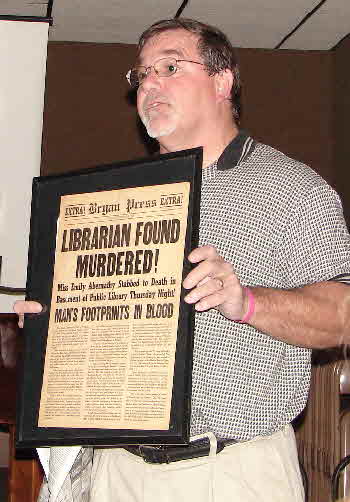
Speaking to an audience at the Stryker American Legion Hall, Kelly began his presentation by sharing that most people ask him how he got interested in tracking down stories about local murders. He credited his 7th grade teacher with steering him to the Hardy Boys mystery books. He got hooked on the stories, and read as many of the more than 100 stories as he could get his hands on.
In high school Kelly moved on to Agatha Christie mysteries and in college he received a collection of Sherlock Holmes stories from his family. It seemed like destiny.
“I’ve always been a mystery fan,” Mr. Kelly said. So, one day he was sitting in a restaurant with his friends and asked them what part of local history interested them most. “My friends had questions about the 1946 murder of the Bryan librarian and I said I would look it up.”
“It just took off from there,” he says. He began to document other murders in the county, and as people heard about his interest, they began sharing leads for crimes they had heard about.
Since beginning his research in 1995, Kelly has documented 55 local murders, the first occurring 161 years ago in 1847.
The first murder that took place in Williams County was of a five-year-old boy, David Schamp, near West Unity. Kelly said the murderer was Andrew Tyler, a man who traveled from town to town making money by telling fortunes or whatever he could do to raise some funds. Tyler, noticing the boy’s family had more means than others, hatched a plan to kidnap the boy. Enlisting the aid of an accomplice who was easily manipulated, the boy was kidnapped and killed.
Tyler pretended that he knew how to find the boy while leading volunteers from around the area on futile searches for the boy. Still, Kelly said the family gave Tyler money for his efforts.
But the plan unraveled and Tyler and his accomplice were arrested for the murder and sentenced to die. Tyler became the only person publicly executed in Williams County.
Kelly said a gallows was built next to the county jail, which at the time was on the north side of the square in Bryan about where Mantel’s store is today. A crowd of about 3,000 swelled into the city to see the event, but a fence had been built up around the gallows to keep the hanging private. The throng tore the fence down and used the wood to feed fires around the jail to keep warm through the night until the morning when Tyler was hung.
As he continued through other stories, Kelly gave examples of the different types of homicides he has found in his research. Some murders were committed by people out to get money or valuables from someone else, some because of marital difficulties, some due to mental impairments, and some because of unwanted pregnancies.
Mr. Kelly said he has noticed a trend in the cases he has studied. While some murders are committed by people with mental illnesses, by and large he noted, “Most local murders were committed for love or money — or the lack of love or lack of money.”
Mr. Kelly is sensitive to the feelings of those involved in the cases. He began his program saying it has never been his intent to hurt the families of the victims or the perpetrators in the cases he presents. He merely reports on facts that he has gathered. That is also why, while he continues to document recent murders, he doesn’t present events that have happened later than the early 1950s in his public talks. “It’s too soon,” he said. “There might still be some of the people involved around.”
The program was part of a SAHC series designed to promote the area’s rich historical and cultural heritage. The program was held in the Stryker American Legion, whose members also hosted a breakfast for those who wished to eat.
Civil War POW Life Described in SAHC Program at Stryker Legion
The discovery of a diary of a local man who was a POW during the Civil War led a local author to search into his story and ended with the writing of a book about his memoirs.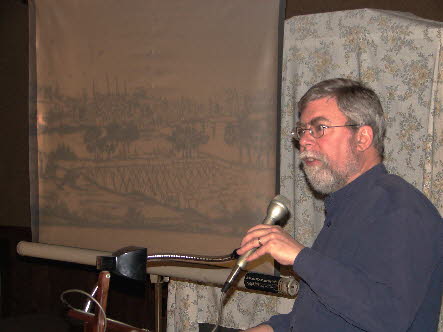
Local historian and author Don Allison shared his journey on the trail of the story in a special presentation based on his book, “Hell on Belle Isle: Diary of a Civil War POW,” sponsored by the Stryker Area Heritage Council on March 15, 2008 at The Stryker American Legion.
“Hell on Belle Isle” is based on the POW diary of Union cavalryman Jacob Osborn Coburn, who helped construct the Michigan Southern & Northern Indiana Railroad from Toledo through Williams County in the mid-1850s. Coburn settled in the Edgerton area and later moved to Michigan.
Coburn’s diary is perhaps the closest a reader can come to experiencing the horrors of Civil War prison life. An uncommonly talented writer, Coburn was an attorney who joined the Sixth Michigan Cavalry in 1862. He turned his pen to describing life as cavalryman in George Armstrong Custer’s famed Michigan Cavalry Brigade, and later as a POW in Richmond in late 1863 and early 1864.
In preparing “Hell on Belle Isle” Allison drew on a lifelong interest and study of the Civil War. His ancestors fought on both sides during the conflict.
“Belle Isle is not as well known as the infamous Andersonville prison in Georgia,” Allison said, “But Belle Isle rivaled Andersonville in terms of the squalid conditions of neglect and starvation endured by its prisoners.”
Life on Belle Isle (pictured above on the screen as Mr. Allison was speaking) was a terrible hardship. Leaky, worn-out tents were provided, but overcrowding often left men with no shelter at all. Rain and cold brought terrible suffering, as did illness, homesickness and an almost continual hunger.
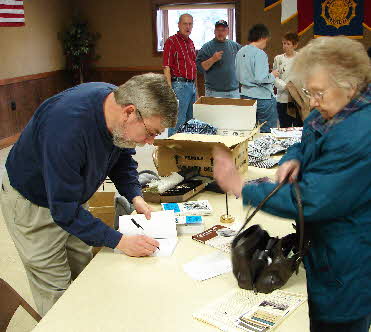 Allison pointed out that at one point in time, Coburn wrote is his diary about how the families of those who died in the POW camps often failed to receive notice of their loved one’s death. Thus, they were always wondering whether their loved one was still alive...waiting for word about their fate that didn’t come. Allison pointed out that at one point in time, Coburn wrote is his diary about how the families of those who died in the POW camps often failed to receive notice of their loved one’s death. Thus, they were always wondering whether their loved one was still alive...waiting for word about their fate that didn’t come.
Reduced to a walking skeleton by his ordeal, Coburn died in a Richmond hospital on March 8, 1864, a victim of starvation and chronic diarrhea. He was one of 40,000 Union soldiers who lost their lives as a POW, Allison said.
Coburn’s family was more fortune than most others who had family members die while prisoners of the war. While in the hospital, Coburn had befriended a nurse, who saved his diary and sent it along with another prisoner who was sent home. The diary was delivered to his father, which is how his ordeal survived
Following the presentation, Allison stayed and autographed copies of his book for those in attendance. For those who may be interested in getting a copy but were not able to attend, he can be contacted at www.fadedbanner.com (or click here to go to a link to his website on our “Links” page).
The free program was part of a series by the SAHC to promote the area’s rich historical and cultural heritage.
SAHC hosts Regional 1 Meeting of Ohio Local History Alliance
Attendees at a regional meeting of the Ohio Local History Alliance learned about native Americans of northwest Ohio, talked about challenges and interesting programs they are doing, and toured the Stryker Heritage Center.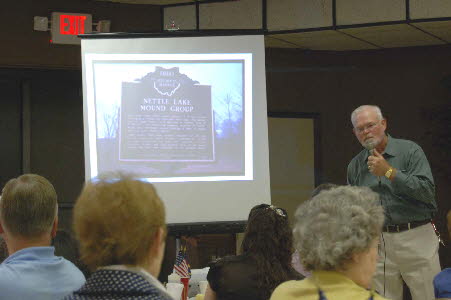
Meeting at the Stryker American Legion on April 21, the group was welcomed by Randy Brown, Alliance Region 1 Representative and Curator of the Wood County Historical Society, SAHC President Terry Perkins and Stryker Mayor Dan Hughes.
The group first heard from Pete Wilhelm, shown talking about the Nettle Lake Indian Mounds in the photo above, professor of history at Northwest State Community College.
He gave a very interesting session about the early territory and its native settlers.
For instance, Indian mounds are found in every Ohio county but one. Can you name that county?
He spoke about the influences of the British and the French, particularly the missionaries who came to be with the native Americans. Some chose to stay and live with the natives and some only stayed the length of their commitment to minister to them and returned home.
He mentioned Johnny Logan, the only Native American buried with full U.S. military honors in Ohio. His burial has a special marker by the Fort Defiance area.
He talked about the influences of native American leaders such as Pontiac, Tecumseh and Little Turtle.
About 30 representatives from area historical societies also heard about interesting ways to spread the word about their programs in a presentation moderated by Janet Rozick, a Region 1 representative and visiting assistant professor at the University of Toledo.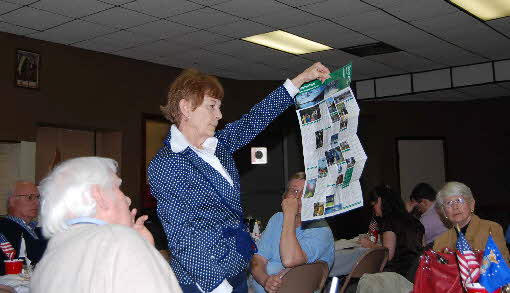
At the afternoon business meeting, Jackie Barton, Director of Education & Outreach for the Ohio Historical Society, said information and guidelines about grants for historical groups will be available by July 1.
Matt Strobel, Civil War 150 AmeriCorps member, reminded members of the group to let him know of events they are holding about the Civil War so they may be included in a statewide list.
There was a roundtable led by Joy Armstrong, Alliance Trustee and Director of the Sylvania Historical Village, where each person gave a couple examples of the outstanding things their organization had done and an issue with which they struggle
In the photo above, she holds up the proof of a map of the Maumee Valley region being considered as a way to promote the rich heritage of the area..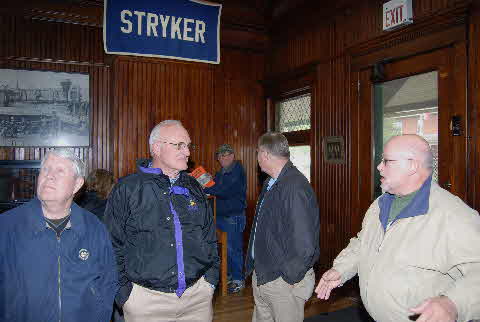
At the conclusion of the program, the representatives toured the Stryker Heritage Center at the depot. In the photo to the left, SAHC President Terry Perkins explains some of the work that was done at the depot for the museum.
A big thanks to the Stryker American Legion for having both a delicious breakfast and lunch for the people on hand and all of the Stryker area merchants who donated items for goody bags for each attendee.
And in case you were wondering, it is Mr. Wilhelm’s home county, Henry County, that is the only one of Ohio’s counties that doesn’t have any documented Indian mounds.
|

